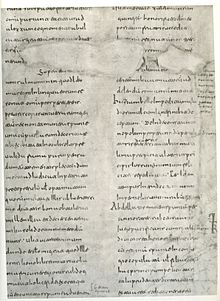
Back Вестготска азбука Bulgarian Vizigótské písmo Czech Westgotische Schrift German Escritura visigótica Spanish Läänegooti kiri ET Écriture wisigothique French Escritura visigótica GL Scrittura visigotica Italian Visigotisch schrift Dutch Escritura visigotica OC
This article includes a list of references, related reading, or external links, but its sources remain unclear because it lacks inline citations. (November 2015) |
This article needs editing to comply with Wikipedia's Manual of Style. (November 2015) |
| Visigothic script littera mozarabica, littera toletana | |
|---|---|
 Alphabet in Visigothic script | |
| Script type | Alphabetic
|
Time period | 7th century to 13th century |
| Direction | Left to right |
| Region | Iberian Peninsula |
| Languages | Medieval Latin |
| Related scripts | |
Parent systems | |
Sister systems | Beneventan, Merovingian |
Visigothic script was a type of medieval script that originated in the Visigothic Kingdom in Hispania (the Iberian Peninsula). Its more limiting alternative designations littera toletana and littera mozarabica associate it with scriptoria specifically in Toledo and with Mozarabic culture more generally, respectively.
The script, which exists in book-hand and cursive versions, was used from approximately the late seventh century until the thirteenth century, mostly in Visigothic Iberia but also somewhat in the Catalan kingdom in current southern France. It was perfected in the 9th–11th centuries and declined afterwards. It developed from uncial script, and shares many features of uncial, especially an uncial form of the letter ⟨g⟩.

Other features of the script include an open-top ⟨a⟩ (very similar to the letter ⟨u⟩), similar shapes for the letters ⟨r⟩ and ⟨s⟩, and a long letter ⟨i⟩ resembling the modern letter ⟨l⟩. There are two forms of the letter ⟨d⟩, one with a straight vertical ascender and another with an ascender slanting towards the left. The top stroke of the letter ⟨t⟩, by itself, has a hook curving to the left; ⟨t⟩ also has a number of other forms when used in ligatures, and there are two different ligatures for the two sounds of ⟨ti⟩ (“hard” or unassibilated and "soft" or sibilated) as spoken in Hispano-Latin during this period. The letters ⟨e⟩ and ⟨r⟩ also have many different forms when written in ligature. Of particular interest is the special Visigothic z ⟨ꝣ⟩, which, after adoption into Carolingian handwriting, eventually transformed into the c-cedilla ⟨ç⟩.

A capital-letter display script was developed from the standard script, with long slender forms. There was also a cursive form that was used for charters and non-religious writings, which had northern ("Leonese") and southern ("Mozarabic") forms. The Leonese cursive was used in the Christian north, and the Mozarabic was used by Christians living in the Muslim south. The cursive forms were probably influenced by Roman cursive, brought to Iberia from North Africa.
Visigothic script has many similarities with Beneventan script and Merovingian script.
| Preview | Ꝣ | ꝣ | Ç | ç | ||||
|---|---|---|---|---|---|---|---|---|
| Unicode name | LATIN CAPITAL LETTER VISIGOTHIC Z | LATIN SMALL LETTER VISIGOTHIC Z | LATIN CAPITAL LETTER C WITH CEDILLA | LATIN SMALL LETTER C WITH CEDILLA | ||||
| Encodings | decimal | hex | dec | hex | dec | hex | dec | hex |
| Unicode | 42850 | U+A762 | 42851 | U+A763 | 199 | U+00C7 | 231 | U+00E7 |
| UTF-8 | 234 157 162 | EA 9D A2 | 234 157 163 | EA 9D A3 | 195 135 | C3 87 | 195 167 | C3 A7 |
| Numeric character reference | Ꝣ |
Ꝣ |
ꝣ |
ꝣ |
Ç |
Ç |
ç |
ç |
| Named character reference | Ç | ç | ||||||